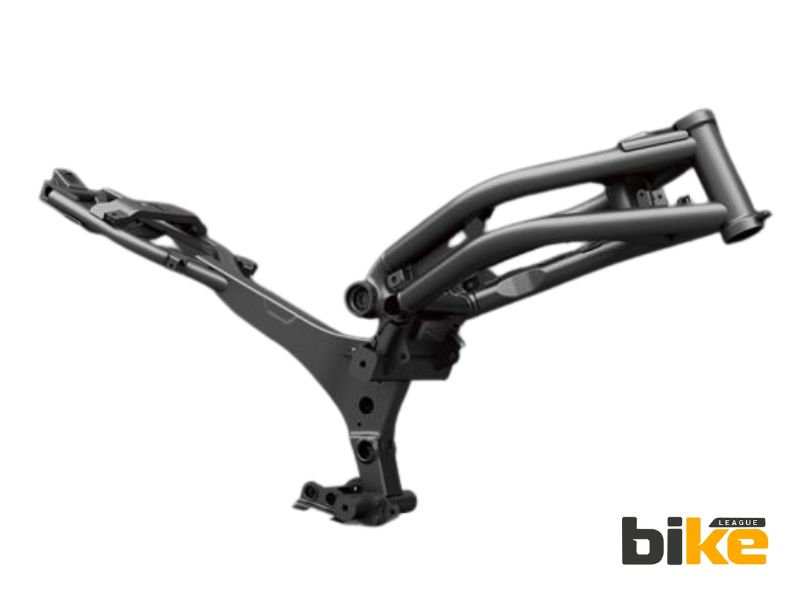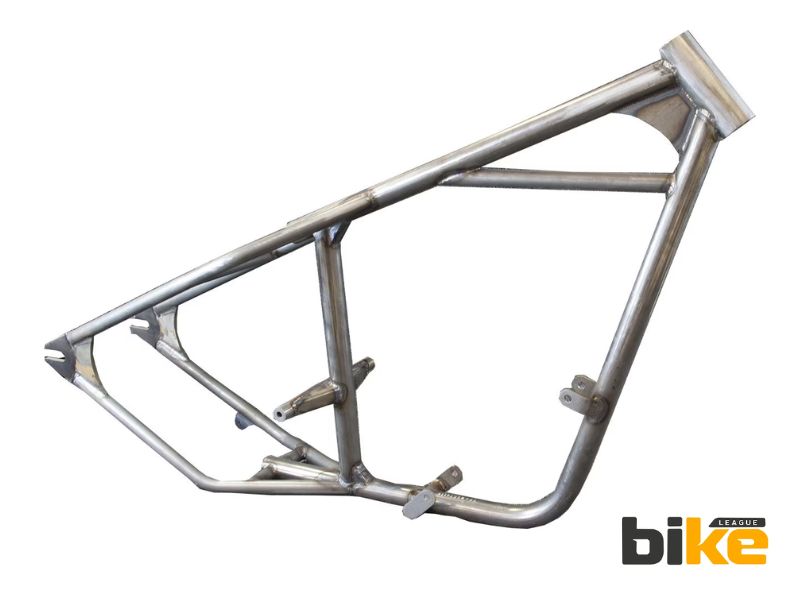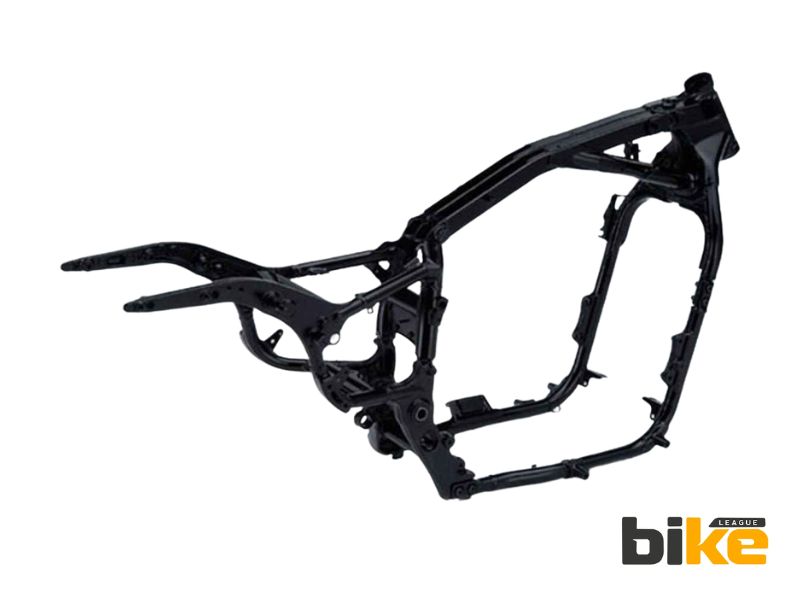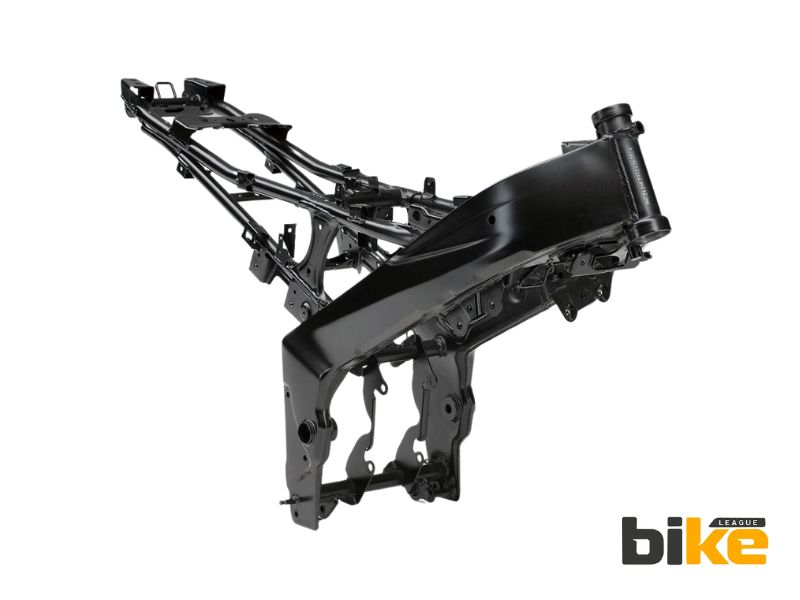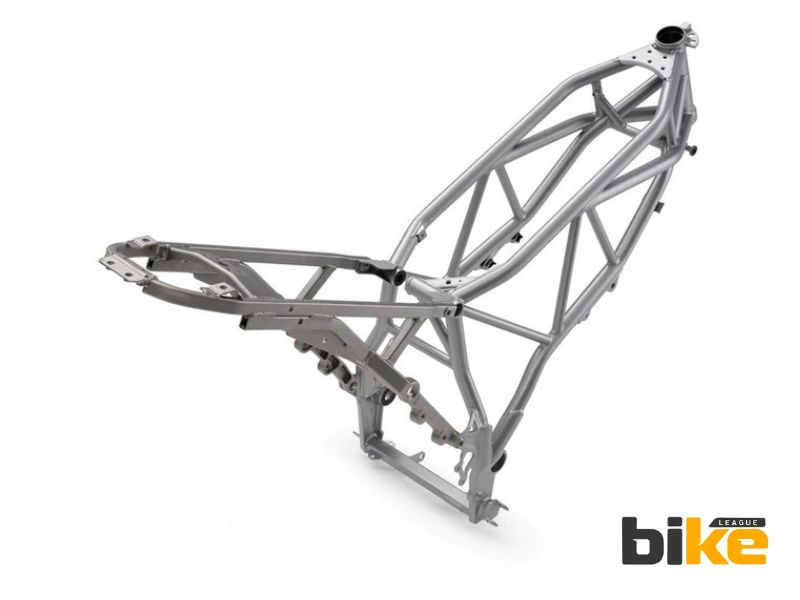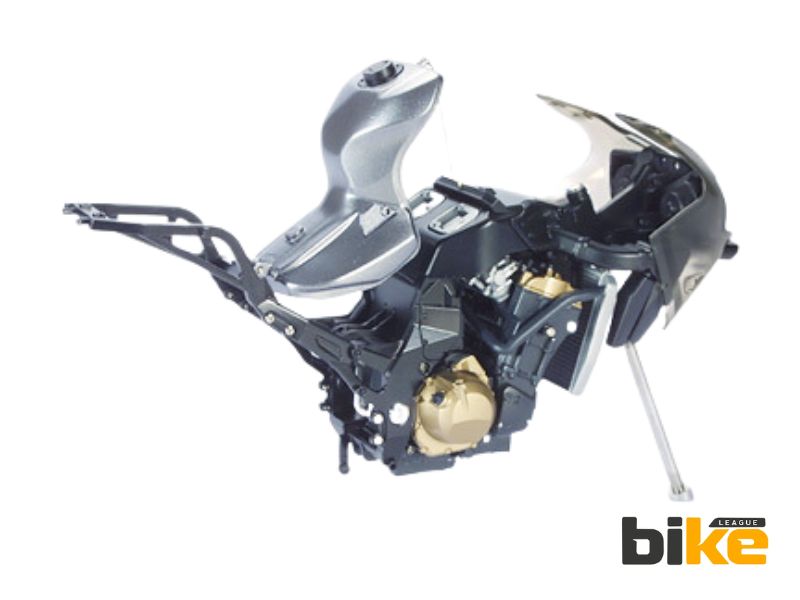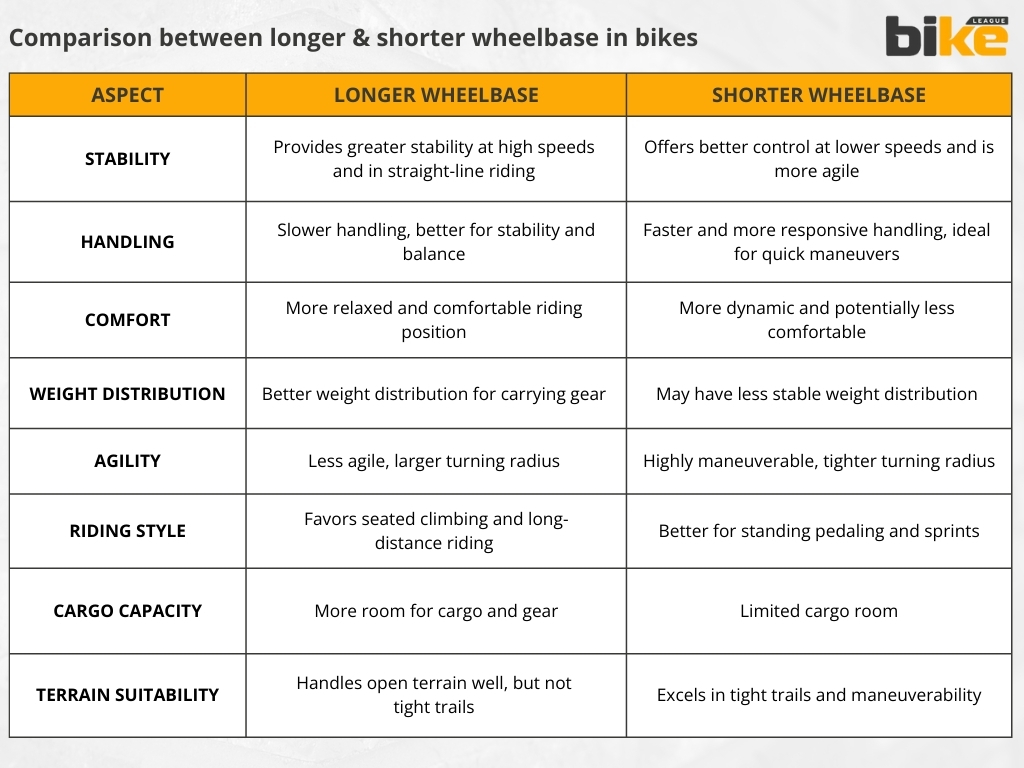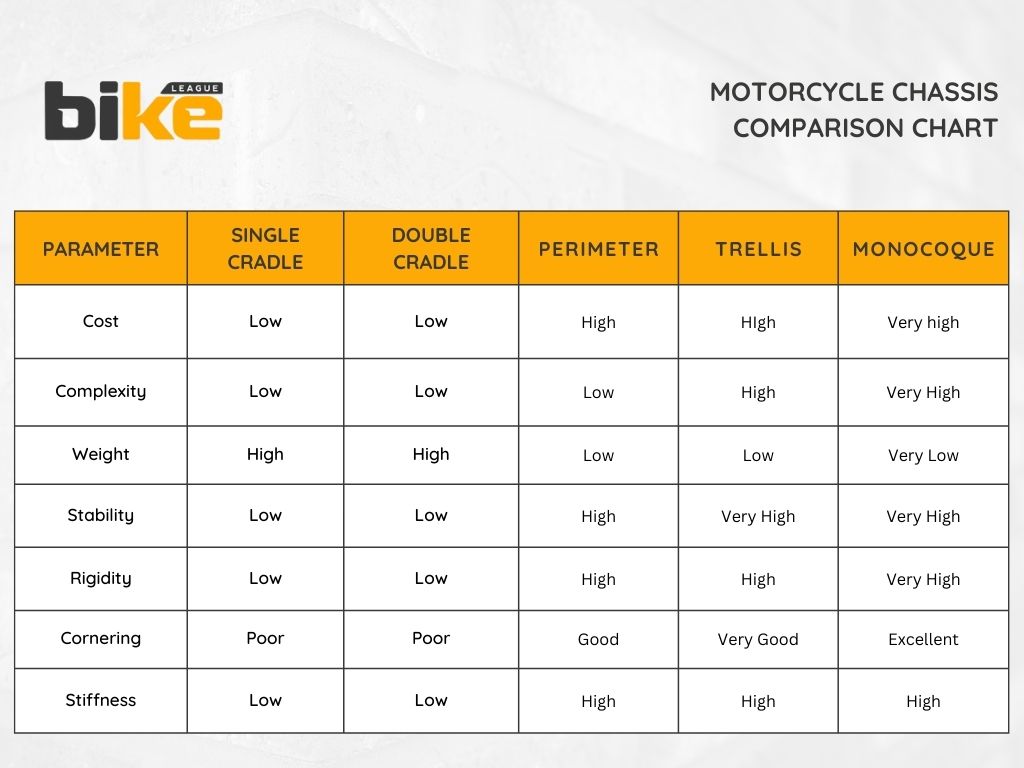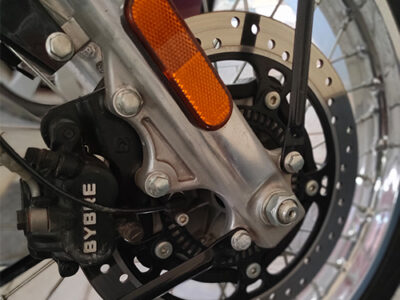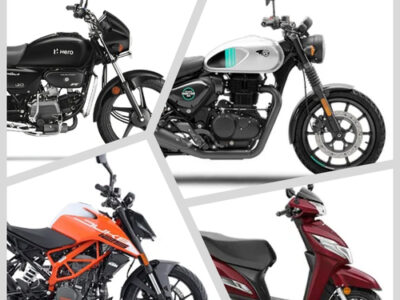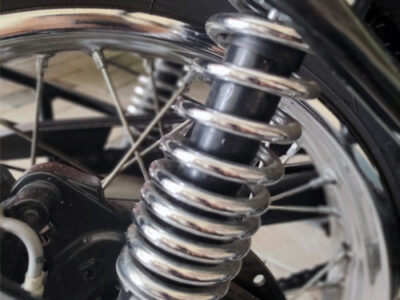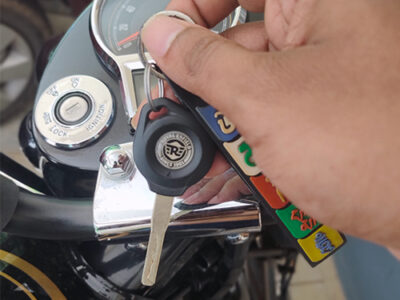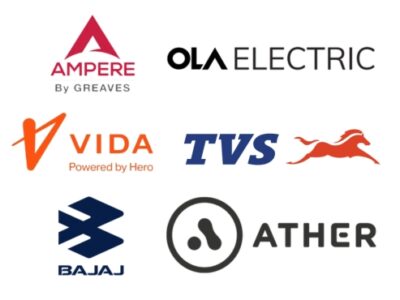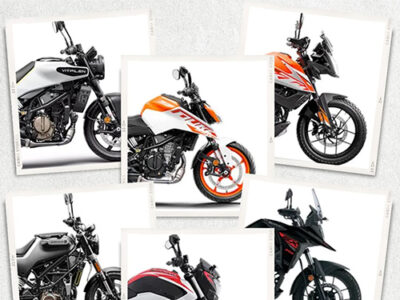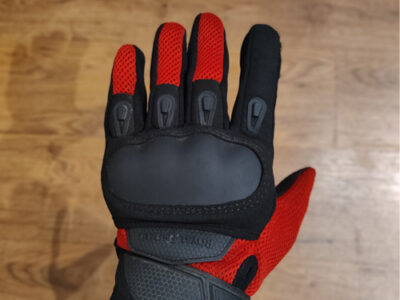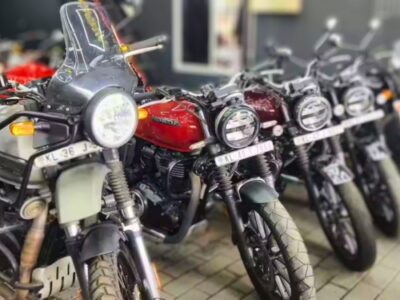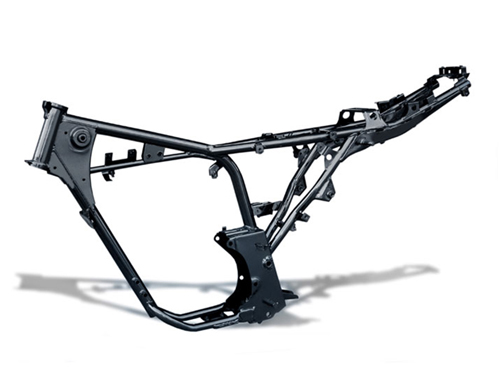
|
Getting your Trinity Audio player ready...
|
Long story short: It’s time to find out which different types of bike chassis/frames are right for your riding style and whether your favourite motorcycle has the right frame.
What is a bike chassis/frames? Why is it so crucial?
The bike chassis or frame is what holds all motorcycle parts together. It does what the skeleton does in our body. So, a bike needs to contribute significantly to the handling and ride quality of the motorcycle. Motorcycles come in different body styles and have unique types of bike frames. To learn more about different types of motorcycles based on body type, check out this article. The main components of the chassis are the frame, the front fork, and the suspension.
Different types of bike chassis/frames
1. Backbone frame
The engine is bolted onto the chassis in the backbone frame, which connects to the rear suspension’s steering head and pivot point. The engine usually hangs off the chassis and acts as a stressed member. This frame is shaped like a spine. It’s the most affordable bike chassis than other frame types due to its simple construction. Conversely, a backbone frame offers less rigidity and strength. Very low-cost motorcycles running smaller engines use backbone frames. Now, motorcycle companies are dropping this frame from their entry-level models due to various disadvantages.
Advantages of backbone frame
- Cheap
- Simple construction
Disadvantages of backbone frame
- Less rigidity
- Low on strength
2. Single cradle frame (Single downtube / Diamond tube)
A single cradle frame is most commonly used on budget-friendly motorcycles. It has a shape and structure similar to a bicycle chassis. It contains steel tubes welded together to form a complete frame. Here, the frame acts as a cradle for the engine. In some cases, motorcycles that employ a downtube frame use the engine as a stressed member. It isn’t the strongest of chassis types, but the overall chassis is light and cheap to manufacture. While talking about the cons, it becomes shaky and unstable under heavy braking or cornering. An example of a motorcycle that uses a single cradle frame is Royal Enfield Bullet 350.
Advantages of single cradle frame
- Simplicity and Cost-Effectiveness
- Suitable for Off-Road Use
- Lightweight Design
Disadvantages of single cradle frame
- Reduced Agility and Performance
- Limited Strength and Rigidity
- Outdated Design
- Engine Installation Challenges
3. Double cradle frame (Twin down tube spine frame)
A double-cradle frame uses two tubes running beneath the engine to support it instead of one steel tube on a single cradle frame. While the structure is cost-effective, it provides a significant advantage over a single cradle chassis in strength and rigidity. This frame handles heavy forces generated during hard braking and high lean angles. However, it is still not used in performance bikes, and better chassis options exist for motorcycles. An example of a motorcycle that uses a Double cradle frame is Royal Enfield Interceptor 650.
Advantages of double cradle frame
- Cost-effective
- Enhanced Strength and Rigidity
- Simple Construction
Disadvantages of double cradle frame
- Limited Agility and Performance
- Outdated Design
- Low Torsional Rigidity
4. Perimeter frame (Twin Spar Frame)
The perimeter frame, or the Twin-spar frame, is one of the most advanced chassis and comes with the most high-performance premium bikes. The twin-spar frame chassis joins the swing arm for the shortest distance possible. The beams that enter the steering head with the swing arm are stiff and light and surround the engine. Earlier, perimeter frames were made of steel; now, almost all modern perimeter frames are lightweight aluminium. The result is that this chassis is more stable and rigid. An example of a motorcycle that uses a perimeter frame is Bajaj Dominar 400.
Advantages of Perimeter frame
- Lightweight
- Stable at high speeds and corners
- Rigid and stiff
Disadvantages of Perimeter frame
- Expensive
5. Trellis frame
The trellis frame has a lot of similarities to the perimeter frame. In the case of the trellis frame, the elements/tubes are arranged using the lattice girder scheme, ensuring the structure is strong, rigid, and lightweight. The trellis frame fares better regarding rigidity and weight than the perimeter frame. It is easier to manufacture and also gives extra strength. An example of a motorcycle that uses a trellis frame is KTM 390 Duke.
Advantages of Trellis frame
- Extra strength
- Very stable at high speeds and corners
- Rigid and lightweight compared to the perimeter frame
- Easy to manufacture
Disadvantages of Trellis frame
- Expensive
6. Monocoque frame
The Monocoque frames are built in highly sophisticated, capital-intensive plants and are generally expensive. The entire skeletal structure is finished as a single, super-stiff piece of metal, termed a monocoque frame. They are for motorcycles with extreme power and demand uncompromising torsional rigidity and lightweight construction. Apart from their complex construction and high precision, such frames often use carbon fibre and magnesium materials. Thus, they are costly compared to other popular frame types. An example of a motorcycle that uses a monocoque frame is Kawasaki Ninja ZX 14R.
Advantages of Monocoque frame
- Super stiff and rigid
- Excellent torsional rigidity
- lightweight
- Made for motorcycles with extreme power
Disadvantages of Monocoque frame
- Very expensive
- Complex construction
Role of wheelbase in bike chassis
The wheelbase is defined as the distance between the centres of a motorcycle’s front and rear wheels. This measurement is crucial as it significantly influences the motorcycle’s handling and stability. A motorcycle’s wheelbase can indicate how it will handle under different conditions.
Short wheelbase
Motorcycles with a shorter wheelbase are known for their agility and ease of handling. They can turn quicker and are easier to manoeuvre in tight spaces, making them ideal for urban environments and racing tracks. The bike’s nimbleness also makes it easier to perform stunts like wheelies and stoppies.
Long wheelbase
Conversely, a longer wheelbase provides greater directional stability, which is beneficial for maintaining a straight line at high speeds on highways. This stability makes long-wheelbase motorcycles more comfortable for long-distance cruising, as they are less prone to wobbling. However, they may be less agile in corners than their shorter counterparts.
FAQ related to different types of bike chassis/frames
1. What role does the wheelbase play in a motorcycle chassis?
The wheelbase, the distance between the front and rear axles, is critical to a motorcycle’s stability and manoeuvrability. A longer wheelbase generally provides better stability at high speeds, while a shorter wheelbase enhances manoeuvrability.
2. What is the significance of frame stiffness?
Frame stiffness is crucial for handling and stability. A stiffer frame can improve the motorcycle’s responsiveness and control, especially during cornering and high-speed riding. However, excessive stiffness can also lead to a harsh ride, so a balance is necessary.
3. Which motorcycle frame material is best?
For budget-oriented motorcycles, steel tube is the main component and is welded according to requirements. Steel is very cost-effective and almost robust, but it is not lightweight. However, the chassis should be light and stiff when we enter performance motorcycles. So, aluminum and alloys are used to achieve these advantages. Carbon fibre, magnesium, and titanium materials are used for ultra-performance racing bikes and street bikes.
4. Which motorcycle frame is the best?
The monocoque frame is undoubtedly the best, but it is costly. The trellis and perimeter frame are in the second spot.
5. Which bike frame is the lightest?
Carbon fibre, magnesium, and titanium material frames have the least weight.
6. Which bike frame is best for aggressive riding?
The perimeter frame and trellis frame are the best. KTM and Ducati use trellis frames for most of their models.
7. Which bike frame do budget-friendly bikes use?
Budget-friendly bikes use single cradle frames nowadays. Earlier backbone frames were present in entry-level models.
8. Is there a size for motorcycle chassis?
No. There are no various size types, so we can select them according to size or weight. Motorcycle companies design bikes based on multiple types of people, considering both height and weight.
9. Can we replace the bike chassis?
Motorcycle chassis can be repaired or replaced, but this can only be done in official service centers. A replacement scenario occurs when a major accident or damage to the chassis occurs. Otherwise, technicians will try to repair the damage. If significant damage occurs to the bike chassis, investing in a new bike will be a better option.
10. How do I find the bike chassis number?
The chassis number is present near the bike’s handle or motor. If you find it challenging to locate your motorcycle, you can seek the help of a mechanic. The owner’s manual and registration certificate mention the bike’s chassis number.
11. How to get a motorcycle chassis number online?
Follow the steps below to find the chassis number.
- Visit the official website of Vahan NR e-Services. Select “Know Your Vehicle Details.”
- Log in with your registered mobile number. Register with your mobile number and email ID if you are using this portal for the first time.
- Enter details of your vehicle and the captcha. Select “Search Vehicle.”
Other related articles from Bikeleague India
- Bike number plates in India – know everything – video
- Motorcycle riding style – How to choose your perfect bike
- Motorcycle Fancy number – How to get your favorite one
- Kawasaki KLX 110
- Aeroride Aero
Conclusion
We have discussed different types of bike chassis/frames, their pros and cons, and some FAQs related to motorcycle chassis. If you have any other doubts or queries, email us at bikeleague2017@gmail.com. You can also share your doubts or opinions in the comments section below. We are always eager to help and assist you. Also, here are several social media platforms of Bikeleague India to raise your suspicions.

